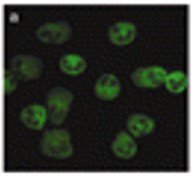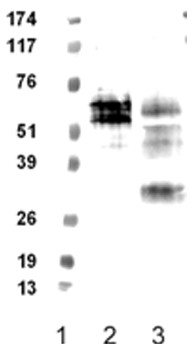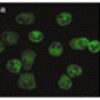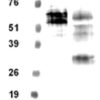Anti-FPR 1/2 Antibody (30107)
$380.00
SKU: 30107
Categories: Antibody Products, Growth Factors/Cytokines/Receptor Antibodies, Products
Overview
Product Name Anti-FPR 1/2 Antibody (30107)
Description Anti-FPR1/2 MAb Mouse Monoclonal Antibody
Target FPR 1/2
Species Reactivity Human
Applications WB,IF
Host Mouse
Clonality Monoclonal
Clone ID NFPR1
Isotype IgG1
Immunogen His-tagged recombinant FPR1 (human neutrophil N-formyl peptide receptor 1) expressed in and purified from Sf9 cells.
Properties
Form Liquid
Concentration Lot Specific
Formulation PBS, pH 7.4.
Buffer Formulation Phosphate Buffered Saline
Buffer pH pH 7.4
Format Purified
Purification Purified by Protein G affinity chromatography
Specificity Information
Specificity This antibody recognizes human FPR1 at aa 305-GQDFRERLI-313 at the amino- terminal portion of the carboxyl-terminal tail. It also recognizes the same epitope in FPR2.
Target Name fMet-Leu-Phe receptor
Target ID FPR 1/2
Uniprot ID P21462
Alternative Names fMLP receptor, N-formyl peptide receptor, FPR, N-formylpeptide chemoattractant receptor
Gene Name FPR1
Sequence Location Cell membrane
Biological Function High affinity receptor for N-formyl-methionyl peptides (fMLP), which are powerful neutrophil chemotactic factors (PubMed:2161213, PubMed:2176894, PubMed:10514456, PubMed:15153520). Binding of fMLP to the receptor stimulates intracellular calcium mobilization and superoxide anion release (PubMed:2161213, PubMed:1712023, PubMed:15153520, PubMed:15210802). This response is mediated via a G-protein that activates a phosphatidylinositol-calcium sPubMed:10514456, PubMed:15153520, PubMed:2161213, PubMed:2176894, PubMed:25109685, PubMed:10514456, PubMed:1712023, PubMed:2161213, PubMed:2176894}.
Research Areas Growth Factors, Cytokines, Receptors
Background Formyl peptide receptors (FPR) are G protein-coupled receptors that are activated by different agonists included N- formylated peptides originating from bacteria and mitochondria. In humans, the FPR family includes the high affinity FPR1, the low affinity FPR2/ALX (previously known as FPRL1 or ALX) and FPR3. Human FPR1 is important for phagocyte chemotaxis, superoxide production, and degranulation, and helps direct phagocytes to sites of infection. Functional FPR1expression has been demonstrated on fibroblasts, bone marrow mesenchymal stem cells, A549 lung cells, HEP-G2 hepatoma cells, and on several types of epithelial cells.
Application Images



Description Immunofluorescence: use at 10ug/ml. Methanol-fixed human neutrophils stained with #30107. See Riesselman M. et al (below) for details.

Description Immunoblotting: use at 1-5ug/ml. Alkali-stripped membranes from rFPR-expressing CHO cells (lane 2) and degranulated human neutrophils (lane 3) blotted with #30107. See Riesselman M. et al (below) for details.
Handling
Storage This product is stable for at least one (1)year at -20°C to -70 C. Store product in appropriate aliquots to avoid multiple freeze-thaw cycles.
Dilution Instructions Dilute in PBS or medium that is identical to that used in the assay system.
Application Instructions Immunoblotting: use at 1-5ug/mL.
Immunofluorescence: use at 10ug/mL.
These are recommended concentrations.
Enduser should determine optimal concentrations for their application.
Immunofluorescence: use at 10ug/mL.
These are recommended concentrations.
Enduser should determine optimal concentrations for their application.
References & Data Sheet
References Riesselman M et al. 2007 J Immunol 179: 2520-2531.
Maaty WS et al. 2013 J Biol Chem 288: 27042-27058.
Maaty WS et al. 2013 J Biol Chem 288: 27042-27058.
Data Sheet  Download PDF Data Sheet
Download PDF Data Sheet
 Download PDF Data Sheet
Download PDF Data Sheet





